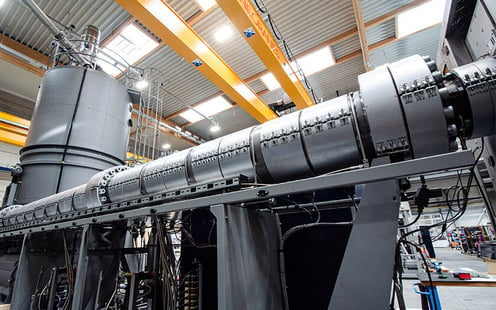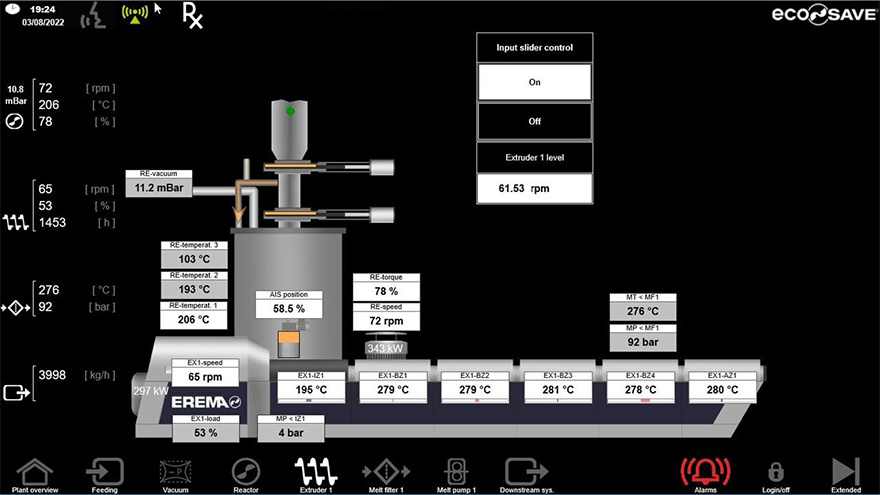Make it new: How EREMA is giving plastics a second life (Austria)

Recycling machines from EREMA return used plastic products to the production cycle, helping customers develop a sustainable circular economy and reduce plastic waste. With comprehensive control system and visualization functions based on zenon, customers benefit from the greatest possible efficiency in engineering and operations.
Highlights
zenon provides visualization and control systems for plastics recycling systems from EREMA
- A single, standardized user interface
- Fast engineering without in-depth software knowledge
- Improved efficiency thanks to recipes
- High energy efficiency with integrated energy monitoring
- Reduced time and expense when testing and commissioning
To keep our planet's ecosystems from collapsing, we have to do more than curb climate change by reducing greenhouse gas emissions. Sustainable business management requires us all to radically reduce the consumption of non-renewable resources such as coal, oil and natural gas. It also means avoiding soil and water pollution from non-degradable waste.
Zero waste
Used plastic products should not end up in landfills or the oceans. Nor is thermal recycling, the downstream use of waste plastics as fuel in district heating power plants, an ideal solution. The goal must be a circular economy where used plastic products flow back into the production chain as secondary raw materials so that new products can be created.
The new products must have the same high quality as the original products from which they are made. Recycling only makes sense financially and environmentally if it saves energy, water, space, and cost. In short, recycling has to be resource efficient.
Leading plastics recycling systems
 As a leading manufacturer, EREMA develops and produces plastics recycling machines for all thermoplastics.
As a leading manufacturer, EREMA develops and produces plastics recycling machines for all thermoplastics.
These are the objectives of EREMA Engineering Recycling Maschinen und Anlagen Ges.m.b.H. in Ansfelden, Austria. A pioneer in the industry when it was founded in 1983, EREMA is today the world leader in the development and building of plastics recycling systems for all thermoplastics, such as PE, PP, PET, PS, ABS, PA, PC, biopolymers, and compounds.
The company is part of the EREMA Group and employs more than 800 people. It builds several hundred systems per year and generates annual sales of EUR 295 million (2021/22). As a pioneer, innovation is key: EREMA holds over 1,000 patents.
Making packaging from packaging
There are more than 6,500 EREMA systems in use around the world. EREMA customers produce more than 14 million tonnes of plastic pellets every year. Annually, they process 2.5 million tonnes of PET into food-grade rPET, which is then used to make beverage bottles and similar products. Customers value EREMA systems because of their high level of innovation, their durability and reliability, their unwavering suitability for food, their safety, and energy efficiency.
In November 2021, EREMA received the Plastics Recycling Award Europe in the "Recycling Machinery Innovation of the Year" category. The award recognizes EREMA's recycling system for processing HDPE food packaging into high-quality recycled material that can be reused in packaging for cosmetics or food.
Universal and high quality
In bottle-to-bottle systems from EREMA, the washed PET bottle flakes are first heated in the reactor under absolute vacuum, pre-dried and cleaned in several stages. For VACUREMA systems, decontamination also takes place in a vacuum reactor. The material is then transferred continuously to the directly connected extrusion unit, gently melted and compressed with the extruder screw, and then filtered at the highest level of fineness. This improves the energy efficiency of the entire process and ensures values remain consistent for color, intrinsic viscosity (IV), and quality.
This is followed by either the production of high-quality, food-safe pellets for further processing or the melt can be processed inline in a single operation, e.g. using a preform unit for making PET bottle preforms or a flat film system for making films.
Complexity and scalability
The machines and equipment from EREMA have a modular structure so they can be combined into highly complex systems, as necessary. These range from pure material processing to turnkey solutions in which the melt is processed directly into the desired end products, such as bottles or films.
EREMA uses programmable logic controllers (PLCs) from a leading European manufacturer to control the individual machines and subsystems. "Due to their complexity, a higher-level solution is required for controlling, operating, and monitoring the entire machine," says EREMA automation engineer Siegfried Blaslbauer. "In order to map the various system complexities, the solution must be easy to operate and scalable without onerous engineering effort."
Equipment visualization with zenon
 EREMA has been using zenon from COPA-DATA for equipment visualization since 1999.
EREMA has been using zenon from COPA-DATA for equipment visualization since 1999.
EREMA began using zenon for machine visualization in 1999. At that time, zenon was not the standard solution but was offered as an option. At that time, Siegfried Blaslbauer had worked at the recycling machine manufacturer for more than a decade. He cites zenon's ability to archive production and operating data as one of the reasons for introducing the zenon software platform from COPA-DATA. Other SCADA systems could not offer the same scope, speed or quality at the time.
“It was important for us to be able to use standard modules in engineering without adding complex programming and we wanted to be able to create visualization projects simply by setting parameters," explains the automation engineer. "As well as enabling this, zenon makes the task even easier with the option of mapping different machine configurations using recipes.”
One system for every requirement
 In addition to the current values, the visualization in zenon also provides historical data and trend reporting to enable end-to-end power monitoring.
In addition to the current values, the visualization in zenon also provides historical data and trend reporting to enable end-to-end power monitoring.
Thanks to zenon's ease of use, zenon very quickly became the standard for visualization on EREMA machines. Their functions have been expanded continuously. The EREMA automation engineers make use of the varied functionalities of the software platform, including batch tracking and energy monitoring. “In addition to the simple integration of the PLC systems, one of the things that speaks in favor of zenon is that it makes it easy to use solutions from many industries,” explains Siegfried Blaslbauer. “These integrated solution packages help us to make running our machines particularly operationally efficient and energy efficient.”
EREMA's zenon applications have moved on from visualizing individual machines. Today, EREMA uses zenon to cover all of the visualization needs of its machines and systems. This includes comprehensive higher-level control of large, complex systems. zenon is also used to connect MES systems, for example, to integrate shift or maintenance plans.
Standardized engineering

EREMA uses Smart Objects to create the visualizations so that intuitive, easy-to-use GUIs are provided simply through configuration.
The automation specialists at EREMA rely on zenon's automation in their engineering. They use Smart Objects found in zenon libraries for creating screens, functions, and combinations. They can be called up anywhere in a zenon project and thus reused as often as necessary. "Engineering with zenon doesn’t replace thinking, but automation with Smart Objects has saved us a lot of time with the current generation of machines," states Martin Kienbauer, head of Automation at EREMA.
Some 200 actuators and sensors are used in EREMA's latest machines, and their functions are controlled by the PLC. The automation specialists from EREMA have created a Smart Object for each of these functions. “This ensures that the function inside the machine matches the behavior in the visualization, which enables us to exclude software incompatibilities as a potential source of an error,” explains Martin Kienbauer. “Our investment has been quickly repaid because zenon reduces the time and expense of testing and commissioning at site by 20 to 30 percent.”
-
In addition to how easy it is to integrate with
PLC systems, zenon also makes it easy to use
solutions from many industries.Siegfried Blaslbauer | Automation Engineer at EREMA Engineering Recycling Maschinen und Anlagen Ges.m.b.H.
Download
-
Get file nowBuilding machines for the circular economy with zenon from COPA-DATAEREMA_SUS_EN.pdf
Wir freuen uns über Ihre Fragen. Kontaktieren Sie uns einfach, wie es Ihnen am liebsten ist: